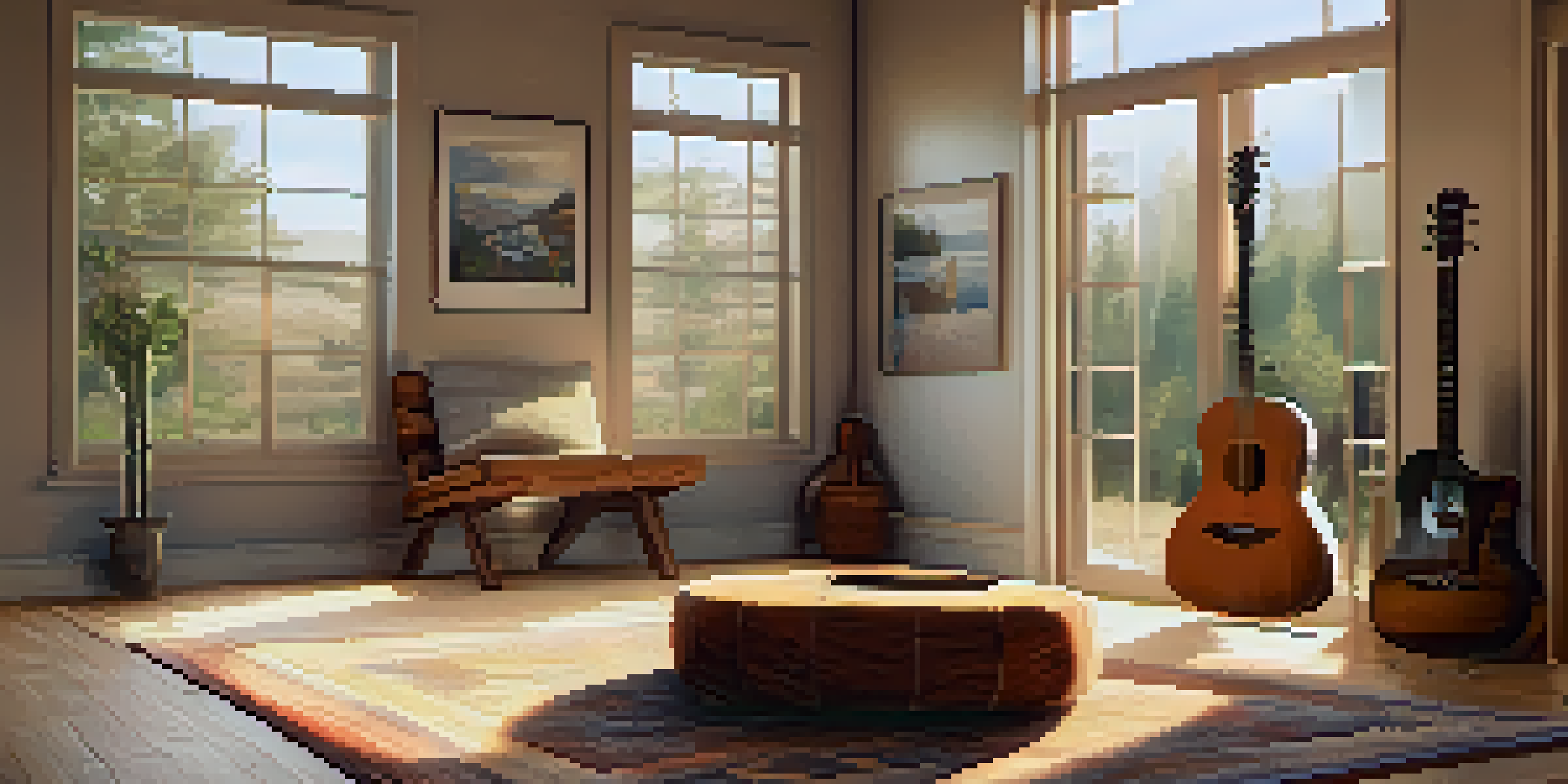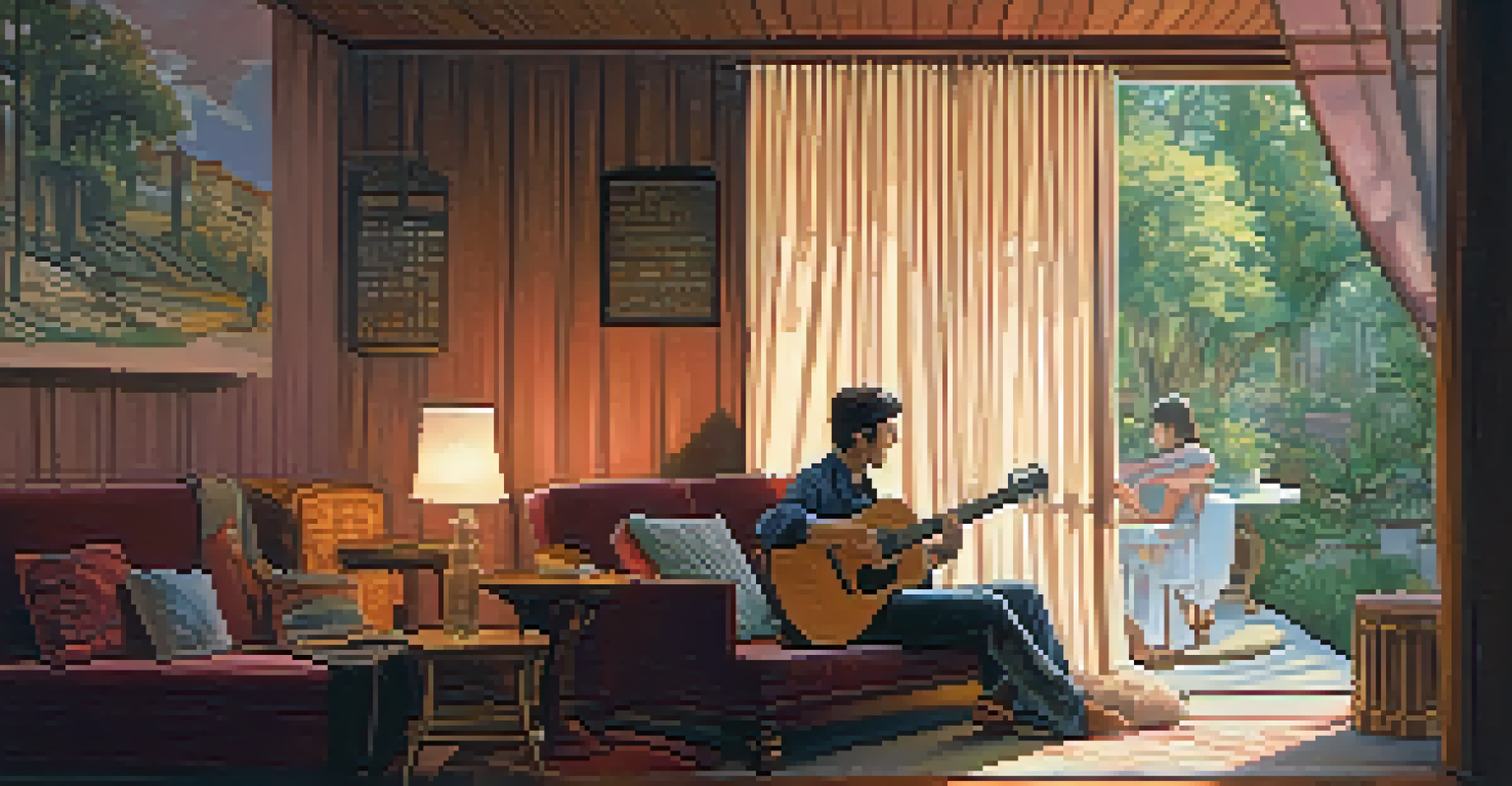How Ceiling Height Affects Acoustic Guitar Performance

Understanding Acoustic Guitar Sound Production
To grasp how ceiling height affects acoustic guitar performance, it's essential to understand sound production. When you strum or pluck strings, vibrations create sound waves that travel through the air. The quality of these sound waves can be influenced by various factors, including the environment around you.
The sound of the guitar is not just in the instrument; it's also in the environment where it is played.
Acoustic guitars rely on their body shape and materials to amplify sound. However, the space in which you play also plays a pivotal role. A room's dimensions, particularly the ceiling height, can either enhance or dampen the sound waves produced.
In essence, the interaction between the guitar's sound waves and the physical space determines how full or hollow the sound will be. So, let’s dive deeper into how ceiling height specifically influences this dynamic.
The Role of Ceiling Height in Sound Reflection
One of the most significant effects of ceiling height is on sound reflection. In spaces with higher ceilings, sound waves have more room to bounce around, leading to richer and fuller acoustics. This can enhance the overall sound quality of your guitar, making each note resonate beautifully.

Conversely, lower ceilings can trap sound waves, causing them to reflect in a limited space. This can result in a muddier sound, where notes may lose clarity and definition. Think of it like playing in a small closet versus an expansive hall; the difference in sound quality is palpable.
Ceiling Height Enhances Sound Quality
Higher ceilings allow sound waves to bounce freely, resulting in richer and fuller acoustics for your acoustic guitar.
Therefore, if you're serious about your guitar performance, consider how the height of your ceiling might be impacting the way your music is heard both by you and your audience.
How Ceiling Height Affects Volume and Projection
Ceiling height doesn't just affect sound quality; it also influences volume and projection. In spaces with high ceilings, acoustic guitars can project sound more effectively, filling the room with a vibrant tone. This is particularly beneficial for performances where you want your music to reach every corner of the space.
Music is the shorthand of emotion.
On the other hand, in rooms with low ceilings, the sound may feel contained or even stifled. This can limit the dynamic range of your performance, making it harder to achieve the full potential of your guitar. Imagine strumming a powerful chord but feeling like the walls are closing in on you; that’s the effect low ceilings can have.
Ultimately, if you're looking to amplify your guitar's sound, a higher ceiling could be your best friend.
The Impact of Room Shape Alongside Ceiling Height
While ceiling height is crucial, the shape of the room also plays a vital role in how sound behaves. For instance, a long, narrow room may produce different acoustic qualities compared to a wide, open space, even if the ceiling height is the same. The interaction of sound waves with walls and corners can create unique acoustic challenges.
When combined with ceiling height, these factors can either complement or contradict each other. A high ceiling in a square room may create a balanced sound, while a high ceiling in a narrow room could lead to odd echoes or uneven sound distribution.
Volume and Projection Matter
A room with high ceilings enables better sound projection, filling the space with vibrant tones, while low ceilings can stifle sound.
So, when evaluating your space for guitar performance, consider not just the height but also the overall shape of the room.
Choosing the Right Space for Acoustic Guitar Practice
Selecting a practice space with optimal ceiling height can significantly enhance your acoustic guitar experience. A room with at least 10 feet of height is generally recommended for acoustic instruments, as it allows for better sound dispersion. This ensures that you can not only hear your guitar clearly but also enjoy the full depth of its sound.
If you find yourself in a space with lower ceilings, consider using sound-absorbing materials like rugs or curtains. These can help mitigate some of the negative effects of a confined space, allowing you to focus on your performance without feeling overly constrained.
Ultimately, the right practice environment can make a world of difference, so take the time to find a space that suits your needs.
Acoustic Treatments for Low Ceilings
If you’re stuck with low ceilings, don’t fret! There are ways to improve your acoustic environment through treatments. Adding acoustic panels or diffusers can help manage sound waves, reducing unwanted echoes and improving clarity. This means you can still achieve a pleasant sound even in a less-than-ideal setup.
Additionally, positioning furniture strategically can also influence how sound travels in a room. Soft furnishings, like couches and curtains, absorb sound and can soften harsh reflections. Think of them as your sound-absorbing allies in a battle against poor acoustics.
Optimize Your Practice Environment
Choosing a room with adequate ceiling height and considering acoustic treatments can significantly improve your guitar practice experience.
With the right adjustments, even a low ceiling can support a decent guitar performance.
Experimenting with Different Spaces and Heights
One of the best ways to understand how ceiling height affects your acoustic guitar is through experimentation. Try playing in various spaces with different ceiling heights and taking note of how the sound changes. This hands-on approach will provide valuable insights into how sound interacts with your environment.
You might discover that you prefer the openness of a high-ceilinged room for certain songs, while other pieces might sound intimate and warm in a cozier space. Each environment can bring out different qualities in your music, offering a unique experience every time.

So, don’t hesitate to explore! Your ideal acoustic space might be just around the corner, waiting for you to discover it.